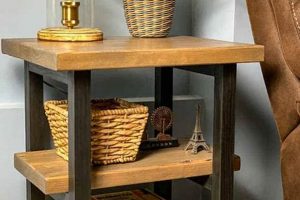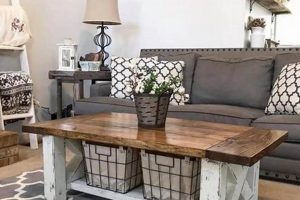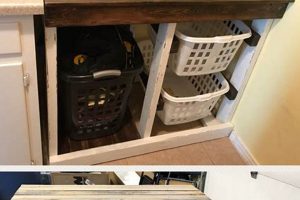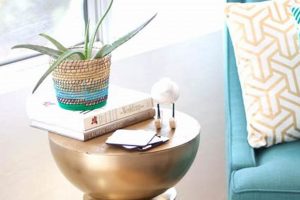A self-assembled dressing table represents an exercise in personalizing one’s living space. These projects typically involve constructing or modifying a surface and incorporating storage solutions, often coupled with a mirror to create a dedicated area for grooming and self-care activities. An example includes repurposing an antique desk with the addition of cosmetic organizers and specialized lighting.
Such constructions provide several advantages. They allow for customization based on available space and budget constraints. Furthermore, they offer an opportunity to express individual style through material selection, color palettes, and design choices. Historically, similar adaptations have been employed to optimize spaces and reflect evolving aesthetic preferences, providing a tangible connection to craftsmanship and resourcefulness.
The remainder of this article will address key considerations for designing and executing these personalized furniture projects, including material selection, tool requirements, construction techniques, and finishing options. These will empower individuals to create functional and aesthetically pleasing dressing areas tailored to their unique needs and preferences.
Construction and Design Considerations
The following guidelines offer advice for individuals embarking on a self-directed dressing table construction project. Adhering to these recommendations will contribute to a more successful and satisfying outcome.
Tip 1: Material Selection. Prioritize materials that align with the intended aesthetic and durability requirements. Solid wood offers longevity, while engineered wood products provide cost-effectiveness. Consider material weight in relation to structural stability.
Tip 2: Space Planning. Accurately measure the available space and create a detailed plan incorporating dimensions. Ensure adequate clearance for comfortable movement around the finished table.
Tip 3: Lighting Integration. Plan for task lighting to provide adequate illumination for grooming activities. Consider integrated lighting options within the mirror or supplementary lamps.
Tip 4: Storage Solutions. Incorporate storage solutions tailored to specific needs. Drawers, shelves, and organizers can maximize space utilization and minimize clutter.
Tip 5: Ergonomic Height. Design the table at a comfortable height for prolonged use. Consider the height of the chair or stool that will be used in conjunction with the table.
Tip 6: Secure Mirror Mounting. Employ appropriate mounting hardware to securely attach a mirror to the table. Ensure the mirror is stable and provides a clear reflection.
Tip 7: Finishing Touches. Apply a durable finish to protect the table’s surface and enhance its aesthetic appeal. Consider stain, paint, or varnish options based on the desired appearance.
Tip 8: Tool Acquisition. Ensure access to necessary tools before commencing construction. This may include measuring tools, sawing implements, fastening devices, and finishing applicators.
Following these guidelines will contribute to a functional and aesthetically pleasing result, aligning with the individual’s specific requirements and preferences.
The subsequent sections will delve into advanced construction techniques and decorative enhancements, providing a comprehensive resource for personalized furniture projects.
1. Space Optimization
Space optimization is a critical consideration in the design and construction of a self-assembled dressing table, particularly in environments where spatial constraints are prevalent. Effective utilization of available area directly impacts the functionality and practicality of the finished piece.
- Wall-Mounted Designs
Wall-mounted units capitalize on vertical space, thereby freeing up floor area. This approach is particularly beneficial in smaller rooms where a traditional free-standing vanity table would impede movement. An example includes a compact, wall-attached surface with integrated storage drawers, effectively converting unused wall space into a functional grooming area.
- Corner Configurations
Corner units are designed to fit snugly into the junction of two walls, often underutilized spaces within a room. These configurations maximize spatial efficiency by conforming to the existing architectural structure. A corner vanity table may incorporate angled shelves and drawers to optimize storage capacity within the available footprint.
- Multi-Functional Integration
Designs that integrate multiple functions within a single piece of furniture contribute significantly to space optimization. A dressing table that doubles as a writing desk, for example, allows for versatile usage and reduces the need for separate furniture items. This approach promotes efficiency in areas with limited square footage.
- Fold-Away Mechanisms
Fold-away designs provide the ultimate space-saving solution by allowing the vanity table to be collapsed and stored when not in use. This type of unit typically features a hinged surface that can be folded down to reveal a mirror and storage compartments. Fold-away vanities are particularly well-suited for environments where flexibility and adaptability are paramount.
These space-optimizing design strategies demonstrate the adaptability inherent in self-assembled furniture projects. By tailoring the design to specific spatial constraints, individuals can create functional and aesthetically pleasing dressing areas, even within limited environments. The success of any such project hinges on careful planning and precise execution, ensuring that the finished piece seamlessly integrates into the intended space.
2. Material Durability
The inherent longevity and resistance to wear exhibited by the selected construction materials directly impact the lifespan and functionality of a self-assembled dressing table. Insufficient material durability results in structural instability, aesthetic degradation, and ultimately, the premature obsolescence of the furniture piece. For example, utilizing low-density particleboard in high-stress areas, such as drawer supports, will likely lead to sagging or collapse over time, negating the benefits of a customized design. Similarly, the selection of a non-water-resistant finish on a surface frequently exposed to cosmetics or cleaning agents precipitates damage, discoloration, and an overall diminished appearance.
Conversely, the judicious selection of durable materials ensures a more robust and enduring final product. Hardwoods, such as oak or maple, possess inherent strength and resistance to impact, rendering them suitable for load-bearing components like table legs and frame structures. Engineered wood products, such as plywood with a high veneer count, offer a stable and warp-resistant substrate for surfaces. Applying a polyurethane or epoxy coating provides a protective barrier against moisture, scratches, and chemical exposure, thereby preserving the aesthetic integrity of the finished vanity table. The increased initial investment in durable materials translates to reduced maintenance costs and an extended service life, maximizing the value proposition of the self-assembly project.
In summary, the correlation between material durability and the overall success of a customized dressing table project is unequivocal. The careful consideration of material properties, aligned with the intended use and environmental conditions, is paramount to achieving a functional, aesthetically pleasing, and long-lasting piece of furniture. Neglecting this critical aspect introduces the risk of structural failure, cosmetic deterioration, and ultimately, the devaluation of the labor and resources invested in the project.
3. Lighting Adequacy
Lighting adequacy is a paramount concern in the design and implementation of self-assembled dressing tables. Insufficient or improperly positioned illumination compromises the user’s ability to accurately assess appearance, effectively perform grooming tasks, and achieve desired aesthetic outcomes. The integration of appropriate lighting solutions directly enhances the functionality and usability of the vanity area.
- Task Lighting Intensity
The intensity of task lighting must be sufficient to provide adequate visibility without causing glare or eye strain. Insufficient illumination necessitates excessive leaning and straining, while overly bright lighting can distort colors and create harsh shadows. Optimal intensity is achieved through the selection of appropriate wattage bulbs or adjustable lighting fixtures.
- Color Rendering Accuracy
The color rendering index (CRI) of light sources significantly impacts the accuracy of makeup application and grooming assessments. Light sources with low CRI values distort colors, leading to inaccurate color matching and application. Selecting light sources with a high CRI, ideally above 90, ensures accurate color representation and facilitates precise makeup application.
- Light Source Placement
The placement of light sources is critical for minimizing shadows and providing even illumination. Sidelighting often casts unflattering shadows, while overhead lighting can create harsh glare. Optimal placement involves positioning light sources on either side of the mirror, at eye level, to provide balanced and shadow-free illumination.
- Adjustability and Control
Adjustable lighting fixtures offer the flexibility to adapt to varying lighting conditions and individual preferences. Dimmable lights allow for customized intensity, while adjustable arms enable precise positioning of the light source. This adaptability ensures optimal illumination for a range of grooming tasks and personal preferences.
The aforementioned facets underscore the critical role of lighting adequacy in the context of self-assembled dressing tables. The thoughtful integration of appropriate lighting solutions, encompassing intensity, color rendering, placement, and adjustability, significantly enhances the functionality and usability of the vanity area, facilitating precise grooming and aesthetic self-assessment. This integration transforms the dressing table from a mere furniture piece into a functional workspace designed for optimal performance.
4. Ergonomic Design
Ergonomic design principles are paramount in the context of self-assembled dressing tables, influencing user comfort, minimizing physical strain, and promoting long-term well-being. Neglecting ergonomic considerations results in discomfort, potential musculoskeletal issues, and diminished user satisfaction.
- Height Optimization
The height of the table surface is a fundamental ergonomic factor. An improperly positioned surface necessitates slouching or excessive reaching, leading to back and neck strain. The optimal height should allow the user to maintain an upright posture with shoulders relaxed and elbows bent at approximately 90 degrees. For instance, if the standard vanity height (approximately 30 inches) does not accommodate the user’s height, a customized design should incorporate adjustable legs or a higher surface elevation.
- Knee Clearance
Adequate knee clearance beneath the table surface is essential for comfortable seating. Insufficient clearance forces the user to adopt an awkward or cramped posture, impeding circulation and causing discomfort. The design must provide sufficient vertical space for the user’s knees and thighs, typically at least 24 inches, allowing for unrestricted leg movement and proper posture.
- Mirror Placement and Angle
The position and angle of the mirror directly impact neck strain and visual clarity. A mirror positioned too high or too low compels the user to tilt the head excessively, leading to muscle fatigue. The ideal placement positions the mirror at eye level, allowing for a natural and relaxed head posture. The mirror angle should be adjustable, accommodating varying viewing distances and lighting conditions.
- Accessibility of Storage
The placement and design of storage compartments, such as drawers and shelves, influence ease of access and minimize unnecessary reaching or bending. Poorly designed storage requires the user to strain or twist, increasing the risk of injury. Storage should be readily accessible from a seated position, with drawers positioned within easy reach and shelves located at a comfortable height.
In summary, the successful integration of ergonomic principles into the design and construction of self-assembled dressing tables directly correlates with user comfort, productivity, and long-term well-being. Careful consideration of factors such as height optimization, knee clearance, mirror placement, and storage accessibility transforms a simple furniture piece into a functional and health-conscious workspace. The principles of ergonomics should guide every aspect of the design and construction process to ensure a truly customized and user-centric outcome.
5. Aesthetic Customization
The intrinsic value of a self-assembled dressing table lies in its capacity for aesthetic customization, differentiating it from mass-produced alternatives. This capacity directly influences the overall visual integration of the table within its intended environment and reflects the individual stylistic preferences of the user. The selection of materials, finishes, hardware, and decorative elements contributes to a cohesive design, tailored to complement existing dcor or establish a distinct aesthetic statement. For instance, a rustic-themed bedroom might incorporate a dressing table constructed from reclaimed wood, finished with a distressed paint technique, and adorned with wrought-iron hardware. Conversely, a contemporary space could feature a sleek table with a minimalist design, fabricated from glass and metal, and illuminated by integrated LED lighting.
The importance of aesthetic customization extends beyond mere visual appeal; it significantly impacts the user’s emotional connection with the furniture piece. A dressing table that aligns with personal aesthetic sensibilities fosters a sense of ownership, pride, and comfort. Furthermore, aesthetic considerations directly influence the functionality of the table. The inclusion of specific storage solutions, such as jewelry organizers or makeup brush holders, reflects the user’s unique needs and habits. Similarly, the integration of personalized lighting fixtures enhances the grooming experience by providing optimal illumination tailored to individual preferences. A self-assembled dressing table is, therefore, not merely a functional object but an extension of the user’s personality and lifestyle.
The successful integration of aesthetic customization principles into the design and construction process presents certain challenges. Achieving a cohesive and visually appealing outcome requires careful planning, attention to detail, and a comprehensive understanding of design principles. Material selection must consider not only aesthetic properties but also durability, cost, and compatibility. Furthermore, the execution of decorative techniques, such as painting, staining, or distressing, demands skill and precision. However, the effort invested in aesthetic customization yields a unique and personally satisfying furniture piece, transforming a functional necessity into an individualized expression of style and taste. The ability to tailor every aspect of the design to specific aesthetic preferences is the definitive advantage of the self-assembled approach.
Frequently Asked Questions
The following addresses common inquiries concerning the design, construction, and maintenance of personalized dressing tables.
Question 1: What is the minimum space requirement for a functional self-assembled dressing table?
The minimum spatial footprint is contingent upon the user’s needs and the chosen design. However, a general guideline suggests a minimum width of 36 inches, a depth of 18 inches, and sufficient clearance for a chair or stool, typically around 24 inches. These dimensions provide adequate surface area and maneuverability.
Question 2: What tools are essential for constructing a basic self-assembled dressing table?
Essential tools typically include a measuring tape, level, saw (hand or power), drill with various bits, screwdriver set, sandpaper, and appropriate fasteners (screws, nails). The precise tool requirements vary depending on the complexity of the design and the materials employed.
Question 3: Which materials are most suitable for a durable and cost-effective self-assembled dressing table?
Plywood offers a balance of affordability and structural integrity, while solid wood provides enhanced durability but at a higher cost. The optimal choice depends on budget constraints and desired longevity. Applying a protective finish, such as polyurethane, is recommended regardless of the material selected.
Question 4: How can appropriate lighting be integrated into a self-assembled dressing table design?
Integrated lighting solutions typically involve the installation of LED strips or bulbs around the perimeter of the mirror. Alternatively, adjustable lamps can be positioned on the table surface. The selected lighting should provide adequate illumination for grooming tasks without creating harsh shadows or glare.
Question 5: How is the ergonomic height of a self-assembled dressing table determined?
The optimal height is determined by the user’s seated height and the height of the chair or stool. The table surface should be positioned at a height that allows the user to maintain an upright posture with shoulders relaxed and elbows bent at approximately 90 degrees. Adjustability is desirable to accommodate different users.
Question 6: What are the recommended maintenance procedures for preserving the aesthetic appeal of a self-assembled dressing table?
Regular cleaning with a mild detergent and a soft cloth is recommended. Avoid abrasive cleaners and excessive moisture exposure. Periodic application of a furniture polish or wax can help protect the surface finish and maintain its luster.
In summation, the successful design and construction of a personalized dressing table hinge upon careful planning, appropriate material selection, and adherence to ergonomic principles. Regular maintenance ensures longevity and preserves aesthetic appeal.
The subsequent section will explore advanced design techniques and innovative storage solutions.
Conclusion
This article has provided a comprehensive overview of the considerations involved in creating a self-assembled dressing table. From spatial optimization and material selection to lighting adequacy, ergonomic design, and aesthetic customization, each element plays a crucial role in the success of such a project. The information presented equips individuals with the knowledge necessary to construct functional and aesthetically pleasing pieces of furniture that meet specific needs and preferences.
The meticulous planning and execution inherent in creating a diy vanity table allow for unparalleled personalization and efficient use of resources. As design trends evolve, the adaptability offered by self-assembly projects remains a valuable asset, enabling individuals to continuously refine and improve their living spaces. The pursuit of this endeavor, therefore, represents a commitment to both functional design and individual expression.







